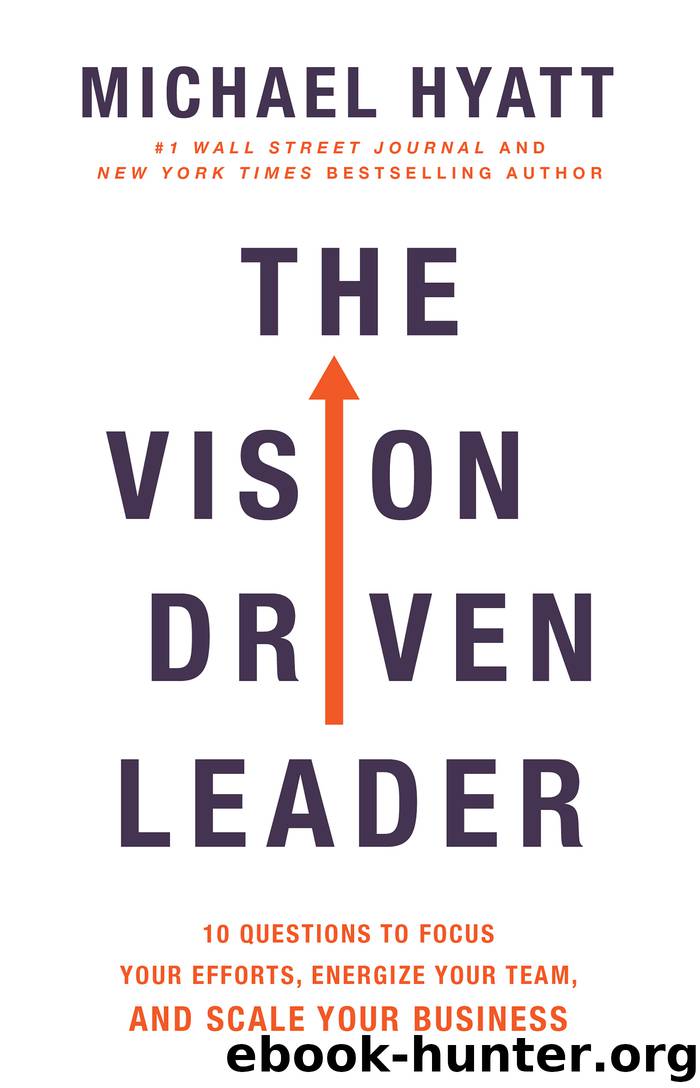The Vision Driven Leader by Michael Hyatt

Author:Michael Hyatt
Language: eng
Format: epub
Tags: Business/Leadership;Coaching of Employees;Leadership;BUS071000;BUS107000;SEL027000
ISBN: 9781493409556
Publisher: Baker Publishing Group
Published: 2020-01-14T00:00:00+00:00
Selling Inside
Let’s say you’ve written your Vision Script. You’ve ensured it’s clear, inspiring, and practical. But at this stage, as I’ve mentioned, you’re not descending Sinai with the tablets. Your vision is still a first draft, capable of reshaping and improvement.
And that’s a plus. Invite refinement from key stakeholders. Not only will you get vital input to improve your vision, people more willingly support what they shape. “The best vision,” as former CEO and consultant Dan Ciampa says, “will come from a disciplined, iterative approach that enables the leader to control how the picture is crafted, while also ensuring that others who need to be aligned feel some ownership.”5
I find it’s best to start with your direct reports. You want to be collaborative here, not dictatorial. “I’ve spent some time reflecting on how to improve our future destination,” you might begin. “This is not about what I’m going to accomplish. Rather, here’s what I believe we could collectively do with all of the talent in this room. I need and welcome your input.” You want their input and validation, yes, but more importantly, you want to enroll them in a journey that you’re going to take together.
I like to think of this internal discussion as tackling three interrelated challenges: change, personnel, and feedback.
1. The change challenge. Most Vision Scripts require changes in how you will do business, which some team members will embrace and others will resist. Some love change. They’re always up for an adventure. They enjoy variety and aren’t fearful of shaking the snow globe. They’re quick to see the need for, and benefits of, change in order to get the win.
Others place a high value on predictability and certainty. They don’t rock the boat and are usually unnerved when others rock their boat. They’re happy or at least satisfied with the status quo and could feel threatened by the implications of your vision. Like leaders and managers, both types of employees are necessary. You need people who can run the ship while others make changes. The goal with selling is gaining alignment, not changing people. You’ve got enough change to manage without adding that to the mix.
I like to start with those who don’t like change. The goal is to make them feel validated by helping them understand there’s an important role for them continuing to do certain aspects of what they’ve been doing. So, when you roll out your vision, it’s important to say, “Here’s what’s not going to change.” In those very words. Your vision should be clear, and so should the language around your vision. As Beau Lotto said, you need to speak “in black and white.”6 This gives certainty-seekers on your team something to hold on to during the changes you’re proposing.
2. The personnel challenge. Job description and job security play a part when discussing a new vision. Your immediate team wants to know: Is my job going to change? Is my compensation going to change? Is my title going to change? If
Download
This site does not store any files on its server. We only index and link to content provided by other sites. Please contact the content providers to delete copyright contents if any and email us, we'll remove relevant links or contents immediately.
Hit Refresh by Satya Nadella(8338)
The Compound Effect by Darren Hardy(7559)
Change Your Questions, Change Your Life by Marilee Adams(6641)
Nudge - Improving Decisions about Health, Wealth, and Happiness by Thaler Sunstein(6633)
The Black Swan by Nassim Nicholas Taleb(6192)
Daring Greatly by Brene Brown(5642)
Deep Work by Cal Newport(5465)
Principles: Life and Work by Ray Dalio(5322)
Rich Dad Poor Dad by Robert T. Kiyosaki(5149)
The Myth of the Strong Leader by Archie Brown(4789)
Man-made Catastrophes and Risk Information Concealment by Dmitry Chernov & Didier Sornette(4736)
Big Magic: Creative Living Beyond Fear by Elizabeth Gilbert(4723)
The Slight Edge by Jeff Olson(4722)
Discipline Equals Freedom by Jocko Willink(4635)
Digital Minimalism by Cal Newport;(4542)
The Motivation Myth by Jeff Haden(4527)
Stone's Rules by Roger Stone(4415)
Management Strategies for the Cloud Revolution: How Cloud Computing Is Transforming Business and Why You Can't Afford to Be Left Behind by Charles Babcock(4131)
The Doodle Revolution by Sunni Brown(4043)
